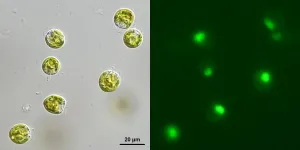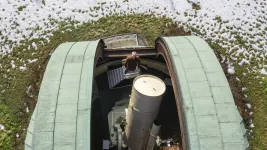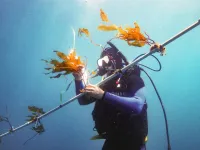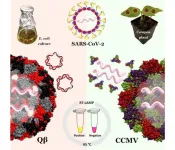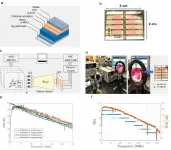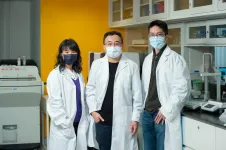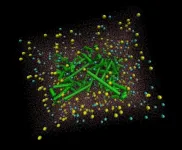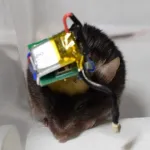Origin of life - The chicken-and-the-egg problem
2021-03-02
(Press-News.org) A Ludwig-Maximilians-Universitaet (LMU) in Munich team has shown that slight alterations in transfer-RNA molecules (tRNAs) allow them to self-assemble into a functional unit that can replicate information exponentially. tRNAs are key elements in the evolution of early life-forms.
Life as we know it is based on a complex network of interactions, which take place at microscopic scales in biological cells, and involve thousands of distinct molecular species. In our bodies, one fundamental process is repeated countless times every day. In an operation known as replication, proteins duplicate the genetic information encoded in the DNA molecules stored in the cell nucleus - before distributing them equally to the two daughter cells during cell division. The information is then selectively copied ('transcribed') into what are called messenger RNA molecules (mRNAs), which direct the synthesis of the many different proteins required by the cell type concerned. A second type of RNA - transfer RNA (tRNA) - plays a central role in the 'translation' of mRNAs into proteins. Transfer RNAs act as intermediaries between mRNAs and proteins: they ensure that the amino-acid subunits of which each particular protein consists are put together in the sequence specified by the corresponding mRNA.
How could such a complex interplay between DNA replication and the translation of mRNAs into proteins have arisen when living systems first evolved on the early Earth? We have here a classical example of the chicken-and-the-egg problem: Proteins are required for transcription of the genetic information, but their synthesis itself depends on transcription.
LMU physicists led by Professor Dieter Braun have now demonstrated how this conundrum could have been resolved. They have shown that minor modifications in the structures of modern tRNA molecules permit them to autonomously interact to form a kind of replication module, which is capable of exponentially replicating information. This finding implies that tRNAs - the key intermediaries between transcription and translation in modern cells - could also have been the crucial link between replication and translation in the earliest living systems. It could therefore provide a neat solution to the question of which came first - genetic information or proteins?
Strikingly, in terms of their sequences and overall structure, tRNAs are highly conserved in all three domains of life, i.e. the unicellular Archaea and Bacteria (which lack a cell nucleus) and the Eukaryota (organisms whose cells contain a true nucleus). This fact in itself suggests that tRNAs are among the most ancient molecules in the biosphere.
Like the later steps in the evolution of life, the evolution of replication and translation - and the complex relationship between them - was not the result of a sudden single step. It is better understood as the culmination of an evolutionary journey. "Fundamental phenomena such as self-replication, autocatalysis, self-organization and compartmentalization are likely to have played important roles in these developments," says Dieter Braun. "And on a more general note, such physical and chemical processes are wholly dependent on the availability of environments that provide non-equilibrium conditions."
In their experiments, Braun and his colleagues used a set of reciprocally complementary DNA strands modeled on the characteristic form of modern tRNAs. Each was made up of two 'hairpins' (so called because each strand could partially pair with itself and form an elongated loop structure), separated by an informational sequence in the middle. Eight such strands can interact via complementary base-pairing to form a complex. Depending on the pairing patterns dictated by the central informational regions, this complex was able to encode a 4-digit binary code.
Each experiment began with a template - an informational structure made up of two types of the central informational sequences that define a binary sequence. This sequence dictated the form of the complementary molecule with which it can interact in the pool of available strands. The researchers went on to demonstrate that the templated binary structure can be repeatedly copied, i.e. amplified, by applying a repeating sequence of temperature fluctuations between warm and cold. "It is therefore conceivable that such a replication mechanism could have taken place on a hydrothermal microsystem on the early Earth," says Braun. In particular, aqueous solutions trapped in porous rocks on the seafloor would have provided a favorable environment for such reaction cycles, since natural temperature oscillations, generated by convection currents, are known to occur in such settings.
During the copying process, complementary strands (drawn from the pool of molecules) pair up with the informational segment of the template strands. In the course of time, the adjacent hairpins of these strands also pair up to form a stable backbone, and temperature oscillations continue to drive the amplification process. If the temperature is increased for a brief period, the template strands are separated from the newly formed replicate, and both can then serve as template strands in the next round of replication.
The team was able to show that the system is capable of exponential replication. This is an important finding, as it shows that the replication mechanism is particularly resistant to collapse owing to the accumulation of errors. The fact that the structure of the replicator complex itself resembles that of modern tRNAs suggests that early forms of tRNA could have participated in molecular replication processes, before tRNA molecules assumed their modern role in the translation of messenger RNA sequences into proteins. "This link between replication and translation in an early evolutionary scenario could provide a solution to the chicken-and-the-egg problem," says Alexandra Kühnlein. It could also account for the characteristic form of proto-tRNAs, and elucidate the role of tRNAs before they were co-opted for use in translation.
Laboratory research on the origin of life and the emergence of Darwinian evolution at the level of chemical polymers also has implications for the future of biotechnology. "Our investigations of early forms of molecular replication and our discovery of a link between replication and translation brings us a step closer to the reconstruction of the origin of life," Braun concludes.
INFORMATION:
ELSE PRESS RELEASES FROM THIS DATE:
2021-03-02
New research suggests that the ability of green algae to eat bacteria is likely much more widespread than previously thought, a finding that could be crucial to environmental and climate science. The work, led by scientists at the American Museum of Natural History, Columbia University, and the University of Arizona, found that five strains of single-celled green algae consume bacteria when they are "hungry," and only when those bacteria are alive. The study is published today in The ISME Journal.
"Traditionally, we think of green algae as being purely photosynthetic organisms, producing their food by soaking in sunlight," said Eunsoo Kim, an associate curator at the American Museum of Natural History and one of the study's corresponding ...
2021-03-02
An international team led by Prof. dr habil. Andrzej Niedzielski, an astronomer from the Nicolaus Copernicus University in Torun (Poland), has discovered yet another three extrasolar planets. These planets revolve around the stars that can be called elder sisters of our Sun.
You can read about the astronomers' success in Astronomy and Astrophysics. The prestigious European journal will publish the paper: Tracking Advanced Planetary Systems (TAPAS) with HARPS-N. VII. Elder suns with low-mass companions. Apart from Prof. Andrzej Niedzielski from the NCU Institute of Astronomy, the team which worked on the discovery includes Prof. dr habil. Gracjan Maciejewski, also from the NCU Faculty of Physics, Astronomy and Informatics, Prof. Aleksander Wolszczan (Pennsylvania State ...
2021-03-02
For several years now, the biofuels that power cars, jet airplanes, ships and big trucks have come primarily from corn and other mass-produced farm crops. Researchers at USC, though, have looked to the ocean for what could be an even better biofuel crop: seaweed.
Scientists at the USC Wrigley Institute for Environmental Studies on Santa Catalina Island, working with private industry, report that a new aquaculture technique on the California coast dramatically increases kelp growth, yielding four times more biomass than natural processes. The technique employs a contraption called the "kelp elevator" ...
2021-03-02
Australia's marine World Heritage Sites are among the world's largest stores of carbon dioxide according to a new report from the United Nations, co-authored by an ECU marine science expert.
The UNESCO report found Australia's six marine World Heritage Sites hold 40 per cent of the estimated 5 billion tons of carbon dioxide stored in mangrove, seagrass and tidal marsh ecosystems within UNESCO sites.
The report quantifies the enormous amounts of so-called blue carbon absorbed and stored by those ecosystems across the world's 50 UNESCO marine World Heritage Sites.
Despite covering less ...
2021-03-02
Rapid COVID-19 tests are on the rise to deliver results faster to more people, and scientists need an easy, foolproof way to know that these tests work correctly and the results can be trusted. Nanoparticles that pass detection as the novel coronavirus could be just the ticket.
Such coronavirus-like nanoparticles, developed by nanoengineers at the University of California San Diego, would serve as something called a positive control for COVID-19 tests. Positive controls are samples that always test positive. They are run and analyzed right alongside patient samples to verify that COVID-19 tests are working consistently and as intended.
The positive controls developed at UC San Diego offer several advantages over the ones currently used in COVID-19 testing: ...
2021-03-02
Around the world there are currently more than 18 billion internet-connected mobile devices. In the next 10 years, anticipated growth in the Internet of Things (IoT) and in machine-type communication in general, will lead to a world of hundreds of billions of data-connected objects. Such growth poses two very challenging problems:
How can we securely connect so many wireless devices to the Internet when the radio-frequency bandwidth has already become very scarce?
How can all these devices be powered?
Regular, manual charging of all mobile Internet-connected devices will not be feasible, and connection to ...
2021-03-02
A Hong Kong Baptist University-led (HKBU) research team has developed a novel drug which has the potential to become a next-generation treatment for cancers associated with Epstein-Barr virus (EBV).
The peptide-linked drug, which is responsive to the acidic environment found in tumours, is the first known agent to have successfully targeted two viral proteins that are simultaneously produced by EBV. It also offers a new strategy by increasing the uptake of anti-cancer drugs in tumour cells, thus allowing the application of lower drug dosages which helps reduce treatment side effects and health risks.
The research results were published in the international academic journal Advanced Science.
New drug targets ...
2021-03-02
Modern electronics is approaching the limit of its capabilities, which are determined by the fundamental laws of physics. Therefore, the use of classical materials, for example, silicon, is no longer able to meet the requirements for energy efficiency of the devices. Currently, it is necessary to start searching for new materials, new principles of electronic devices' functioning. To solve this problem, researchers of Peter the Great St.Petersburg Polytechnic University (SPbPU) are developing thin films, the elements for biomolecular electronics. Scientists believe that biological macromolecules such as nucleic acids, proteins, amino acids can become a promising material for modern ...
2021-03-02
Overview:
A research team at the Department of Electrical and Electronic Information Engineering, Department of Computer Science and Engineering, Department of Applied Chemistry and Life Science, and the Electronics-Inspired Interdisciplinary Research Institute (EIIRIS) at Toyohashi University of Technology has developed a lightweight, compact, Bluetooth-low-energy-based wireless neuronal recording system for use in mice. The wireless system weighs END ...
2021-03-02
A number of scientists whose work is inspired by natural behavior is constantly growing. The lotus flower, with its ability to self- clean, is commonly described in literature and can be best examples the trend. Researchers started to wonder why the flower behaves in this manner and they decided to study its structure with the use of microscopes. Hence, they could draw the conclusion that the structure is highly hydrophobic, i.e. it maintains water drops on the surface. Water then collects particles of dust and by flowing down, removes them by flowing down. It means the adhesion forces, those responsible ...
LAST 30 PRESS RELEASES:
[Press-News.org] Origin of life - The chicken-and-the-egg problem
